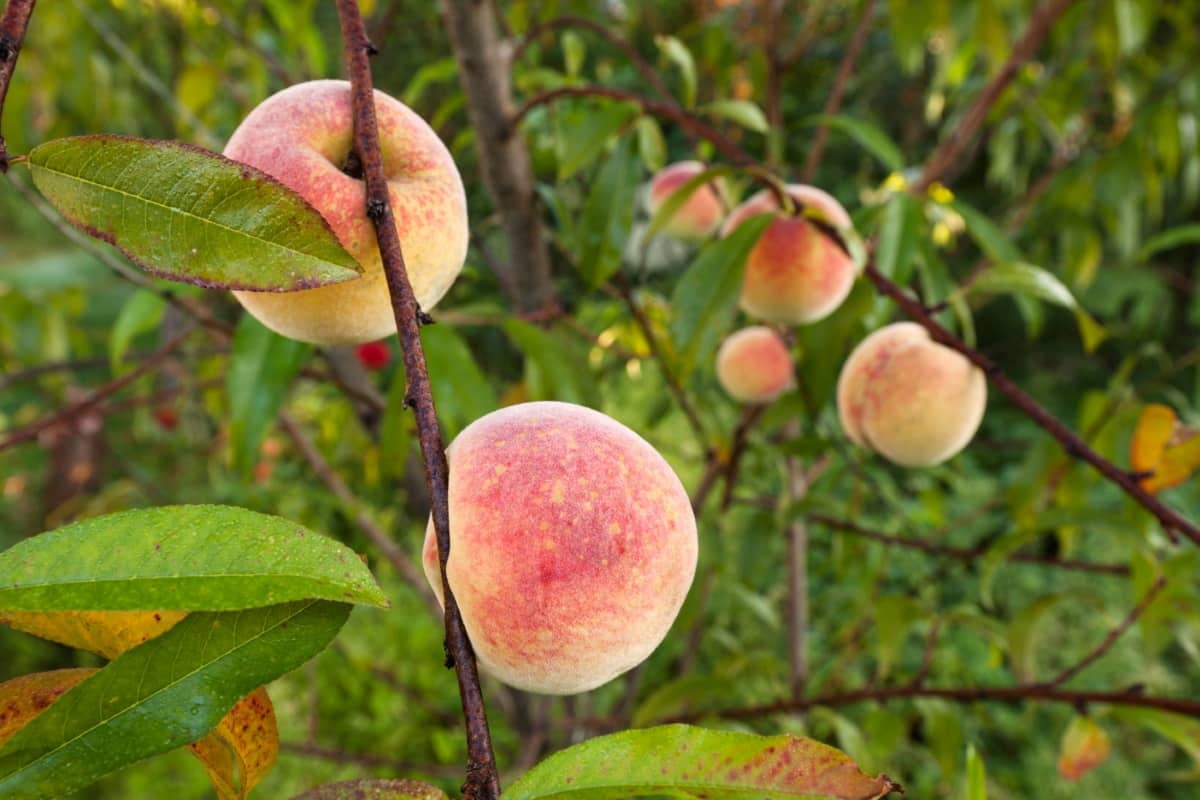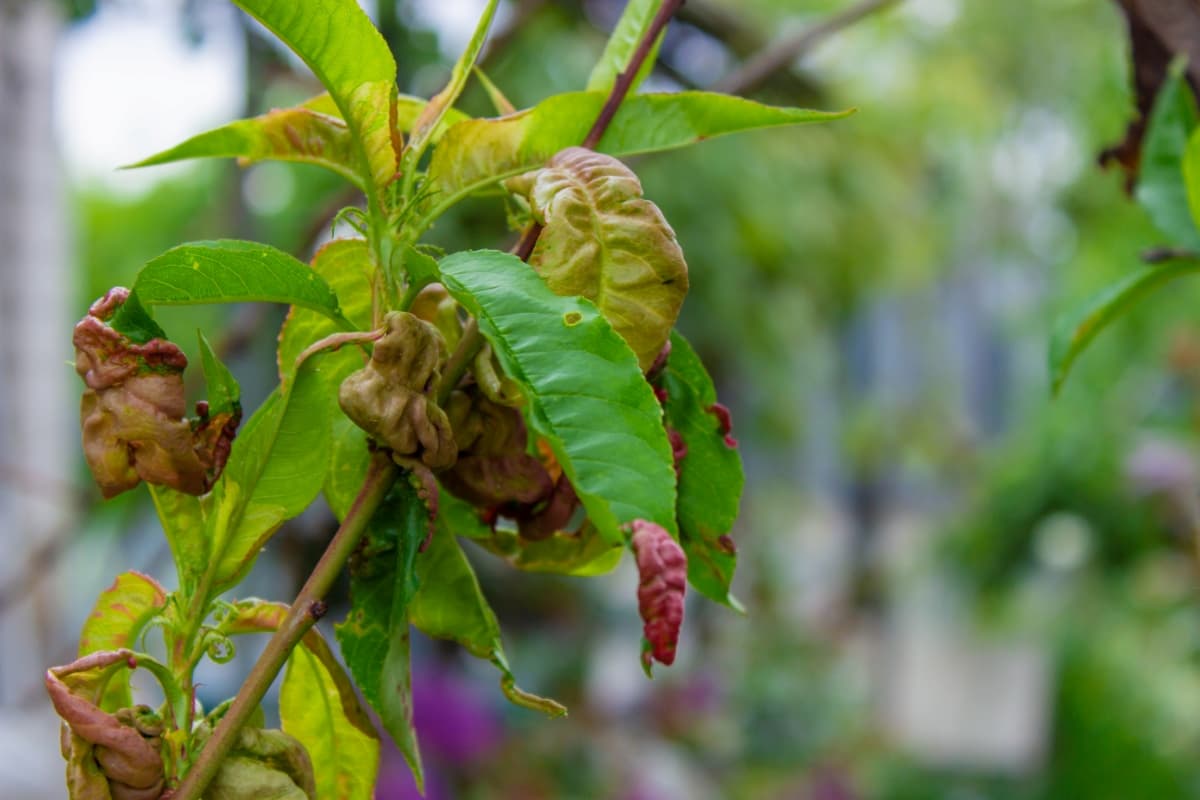Dying peach trees are a common problem for many gardeners as peach trees can be very sensitive to environmental conditions. The causes of a dying peach tree can range from disease or pest problems to improper care or environmental conditions. Here are nine possible causes of a dying peach tree and how to fix it:

9 Causes of Dying Peach Trees
Why is My Peach Tree Dying in Summer Heat, and How Can I Save It?
The summer heat can be difficult for a peach tree to overcome. The ideal summer temperature for a peach tree is between 21 and 27 °C. Temperatures above 27°C can be damaging, as the tree may become dehydrated and unable to produce fruit. Additionally, extreme heat can cause a decrease in the tree’s ability to resist pests and diseases.
To save the tree, water it deeply and regularly, ensuring the soil is damp at least a few inches below the surface. Secondly, make sure that the tree is mulched. Thirdly, consider pruning the tree to help it cope better with the heat. Pruning helps to reduce stress on the tree by allowing for better air circulation and less foliage. Finally, apply a layer of shade cloth or burlap over the tree to provide it with additional protection from the sun.
Preventing Peach Tree Death from Fungal Infections: Effective Remedies and Prevention Tips
- Powdery mildew: Organic fungicides include sulfur, a natural fungicide, and neem oil. These organic fungicides are available in liquid or wettable powder formulations and should be applied according to the manufacturer’s instructions.
- Leaf curl: Regarding addressing peach leaf curl, fungicides with active ingredients like chlorothalonil, copper, and Ferbam can be effective.
- Brown Rot: As a preemptive step against brown rot, applying an all-purpose fungicide before spring blossoms appear can be helpful.
- Peach Scab: You can control peach scab by applying fungicides like captan, chlorothalonil, and a class of fungicides known as demethylation inhibitors.
Identifying Nutrient Deficiencies in Peach Trees and Remedies to Revive Them
Identifying nutrient deficiencies in peach trees can help identify problems and ensure the tree is healthy and productive. Examine the foliage. If the leaves are yellow or pale, it may indicate nitrogen or iron deficiency. If the leaves are small or distorted, it may be a sign of magnesium or zinc deficiency. If the leaves have brown or dead spots, it could be due to a lack of calcium, magnesium, manganese, or potassium.
If the soil lacks nitrogen, you can fertilize the soil with a nitrogen-rich fertilizer to restore the nitrogen levels. If the soil lacks trace minerals, such as iron, zinc, and manganese, you can amend the soil with compost or other organic materials. Once you have amended the soil, provide regular deep watering to the tree. Deep watering is important because it helps the roots absorb the soil’s nutrients.
How to Protect Peach Trees from Pests and Diseases to Prevent Decline and Death
- Inspect your trees for signs of pests and diseases. Look for signs such as discolored or wilted leaves or lesions on the bark. If you notice these signs, take action immediately.
- You can use physical barriers to protect your trees from pests. Fencing or netting can help keep out larger pests, while insecticides can repel smaller pests.
- You can use biological control methods such as beneficial insects to protect your peach trees. These insects can help to keep pests and diseases in check.
- You can also use chemical control methods to fix pest or disease problems. Make sure to use the correct chemicals and follow the instructions carefully.
Overwatering Issues in Peach Trees: Signs, Symptoms, and Steps to Rescue a Dying Tree
When a peach tree is overwatered, the roots cannot absorb oxygen, causing them to suffocate and die. This can lead to other problems, including leaf yellowing, root rot, and decreased yields.
- If the leaves begin to yellow, and the soil around the tree’s base is constantly wet, the tree will likely be overwatered. If unsure, you can also check the tree’s root system for signs of root rot.
- Reduce the frequency of watering. If the tree is on an automatic irrigation system, adjust the settings so that the tree receives less water.
- If the soil stays wet for more than a few hours after watering, you may need to adjust your watering schedule or add more drainage.
Underwatering Issues in Peach Trees: Signs, Symptoms, and Steps to Rescue a Dying Tree
Underwatering is one of the most common issues facing peach trees. It occurs when the tree is not receiving enough water and can cause various issues such as wilting, leaf scorching, leaf drop, and even death.
In case you missed it: 9 Causes of Dying Sweet Lemon Trees and How to Fix Them

Make sure it is getting enough water. Watering a peach tree deeply and thoroughly is key to preventing underwatering. This means soaking the soil around the tree to a depth of at least 12 inches. The tree should be watered at least twice a week during summer. During the winter, the tree should be watered every few weeks. Additionally, mulching around the tree’s base can help to retain moisture in the soil.
Peach Tree Winter Damage/dying: Protecting Trees from Frost and Cold Temperatures
The temperature that will kill a Peach Tree in Winter is anything below -12°C. Peach Trees are not cold or hardy and can suffer damage or even death if exposed to temperatures below -12°C. While Peach Trees can survive temperatures as low as -10°C, they may sustain significant damage.
Most Peach Trees can tolerate temperatures up to -20°c, but temperatures lower than that can kill them. Covering the tree with a winter blanket or burlap is best to protect it from extreme temperatures and wind. Additionally, the tree should be given supplemental water to survive during the cold winter months.
Improper Pruning May Cause Bay Tree Death: Pruning Methods for Healthy Growth.
Improper pruning of peach trees can have a devastating effect on the health of the trees, potentially leading to death. When pruning a peach tree, it is important not to remove too much of the tree’s foliage, as this can weaken the tree’s ability to photosynthesize and can reduce its store of energy.
When pruning, don’t take too much of the tree’s bark away, as this can make it vulnerable to disease and pests. Pruning should not be done too close to the tree’s base, as this can lead to the splitting of the tree’s trunk. If proper pruning is not done, it can lead to the tree’s death. It is, therefore, important to prune a peach tree carefully and precisely to ensure its health.
Reviving a Stressed Peach Tree: Rehabilitation Methods for Overall Recovery
Reviving a stressed peach tree is to examine it and determine the cause of the stress. Common causes include insufficient water and nutrients, pest or disease infestations, or a lack of sunlight. Once the cause is recognized, steps can be taken to mitigate the stress and start rehabilitation.
- One of the most important steps in reviving a stressed peach tree is to provide it with proper irrigation.
- Fertilizing your stressed peach tree can also help in its recovery.
- If you suspect that your tree is suffering from a disease, it is important to identify the source of the illness and treat it accordingly.
- Common pests that attack peach trees include aphids, mites, and borers. If you find any evidence of pests, you must take the appropriate action to remove them and prevent further damage to your tree.
In case you missed it: 9 Causes of Dying Black Pepper Vines and How to Fix Them?

Conclusion
To revive a dying peach tree, it is important first to identify the problem cause and then initiate the appropriate steps to address it. The tree may recover and be restored to its former glory with the appropriate steps taken.
- Ultimate Guide to Ossabaw Island Hog: Breeding, Raising, Diet, and Care
- Ultimate Guide to Juliana Pig: Raising Facts, Size, Diet, Care, and Lifespan
- Raising Lleyn Sheep: Disadvantages, Price, Uses, Characteristics, and Care
- Ultimate Guide to Meishan Pig: Breed Facts, Breeding, Raising, and Care
- Ultimate Guide to Teacup Pigs: Raising, Diet, Lifespan, Cost, and Care
- Guide to Raising Poll Dorset Sheep: Facts, Profile, Characteristics, Uses, and Care
- Ultimate Guide to Bighorn Sheep: Characteristics, Diet, Lifespan, Breeding, and Lifecycle
- Ultimate Guide to Raising Katahdin Sheep: Farming Facts, Breed Profile, Uses, and Care
- Ultimate Guide to Raising Oreo Cows: Belted Galloways Farming Facts, Profile, Uses, and Care